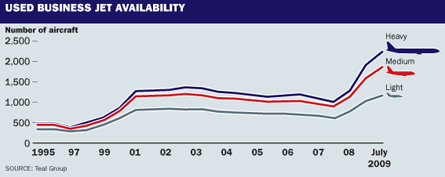The used aircraft market has been suffocated by the economic downturn. Since the start of the crisis a year ago a substantial portion of the world's business aircraft fleet has been put up for sale, dragging down the prices of pre-owned and new models. Months earlier the contrast could not have been more stark, with owners and deposit holders commanding jaw-dropping premiums for their business jets, particularly large-cabin types.
The outlook is particularly gloomy for models at the bottom end of the business aircraft spectrum, where the availability of light, superlight and some midsize aircraft has become so widespread that owners have been forced to lower the price tags of aircraft to previously unheard-of levels. While many analysts are predicting that the market is beginning to recover, some models are difficult to shift.
"The finance tap was turned off in September last year and prices [for all models] fell every month until March. Many people are still waiting to see if the market has reached the bottom before they make a purchase," says Andy Hoy, executive director, group sales for business aviation services provider ExecuJet.
He says the recession drove many owners to default on their loans - forcing the banks to repossess many business aircraft. "For many of these banks, such as Prudential and Credit Suisse, business aircraft have become a toxic asset that they no longer want on their books." These aircraft are being sold on the used market for attractive prices and often at a hefty loss.
 |
|---|
However, Hoy admits that as banks have now begun to ease their lending criteria and loosen finance streams, cash buyers can get a bargain in the present market. "It's never been a better time to buy. There is so much choice at a very good price point," he says. "For example, a cash buyer can pick up a used, low-time Learjet 45 for around $5 million - a year ago the same type of aircraft would have sold for $7.5 million. Similarly, used super-midsize Challenger 300s are being sold for around $15 million compared with around $20 million a year ago."
Typical owners or users of light business jets tend to be high net-worth individuals travelling for business or leisure or small to medium-sized companies. Both groups have been hit financially by the economic downturn and are no longer using private aircraft as a means of transport. The whole business aircraft market has suffered because "the bottom feeders have gone", he says.
These are the people who feed the market from the entry point upwards. "But when these aircraft are sold the knock-on effect is felt across the industry from management and charter companies through to fuel supplies and fixed-based operators," Hoy says.
While the lighter end of the market continues to bear the brunt of the downturn, large-cabin aircraft have been less affected and the used fleets are beginning to shift. "But even here there are still bargains to be had," says Hoy. He adds: "A Global XRS will sell for around $45- $50 million today, but at the peak of the market an owner could command about $63 million for the aircraft. A Dassault Falcon 7X that would have sold for $60 million plus in the middle of last year would fetch around $40 million today.
"Within 12 months the last of the distressed stock [aircraft that will sell for any price] will be gone and then demand will begin to increase along with the prices."
Hoy's view is supported by the latest survey from JP Morgan Equity Research. "We've felt a more positive vibe on business jets recently, with used inventory ticking down slightly and flight operations edging upward," says JP Morgan aerospace analyst Joseph Nadol III.
Source: Flight International
















